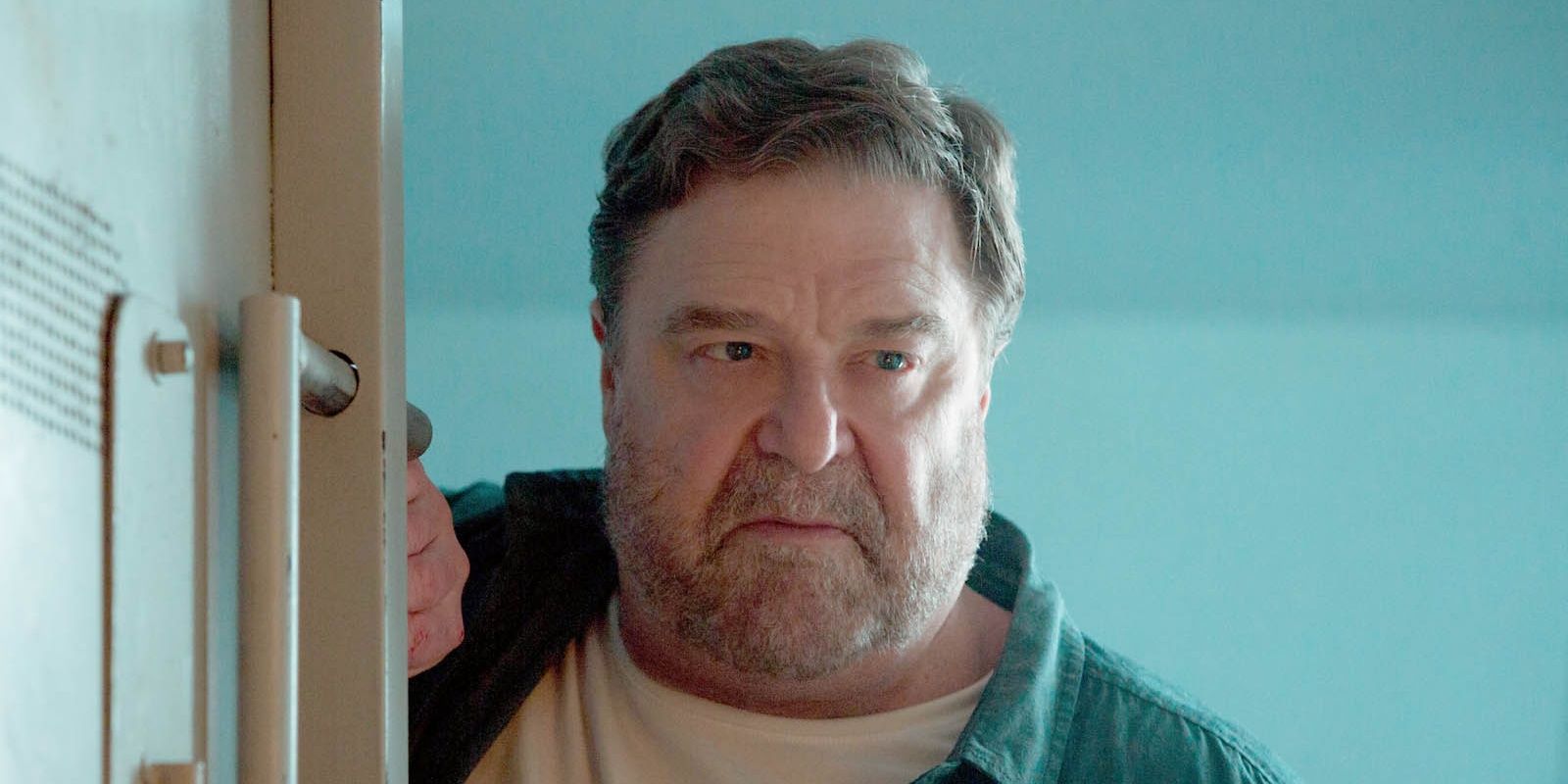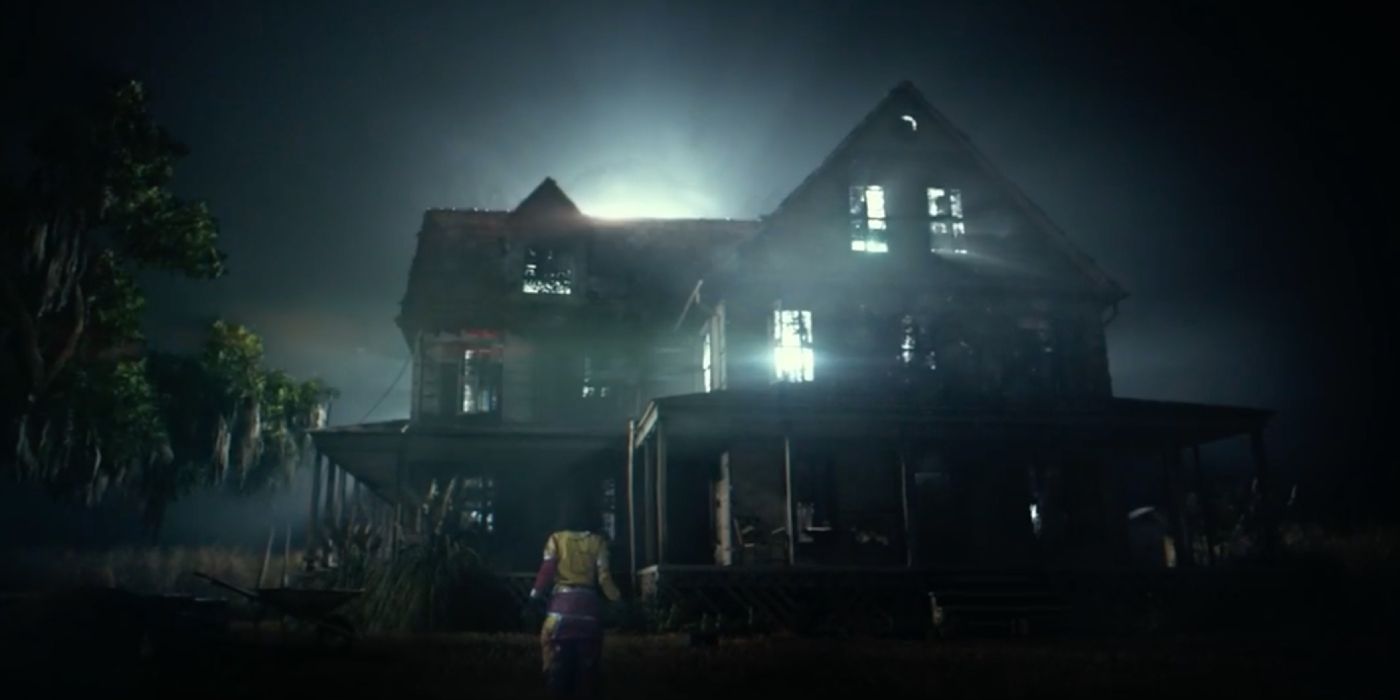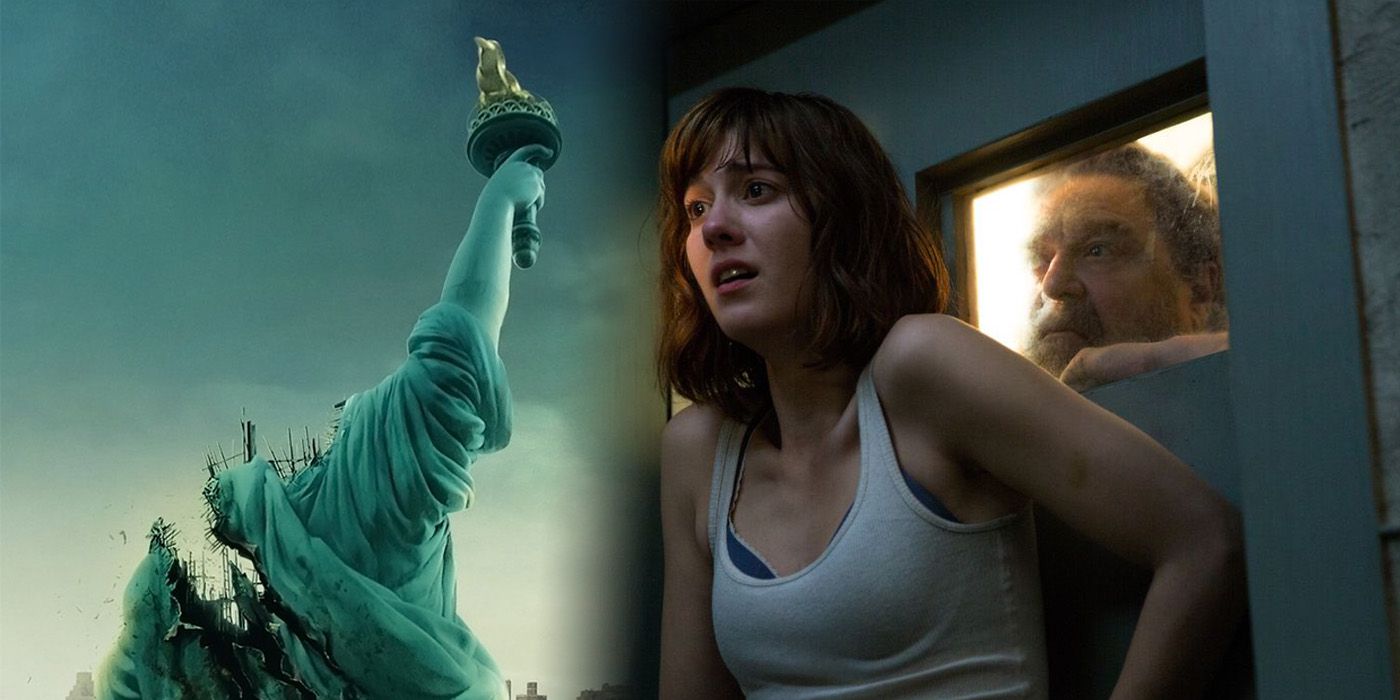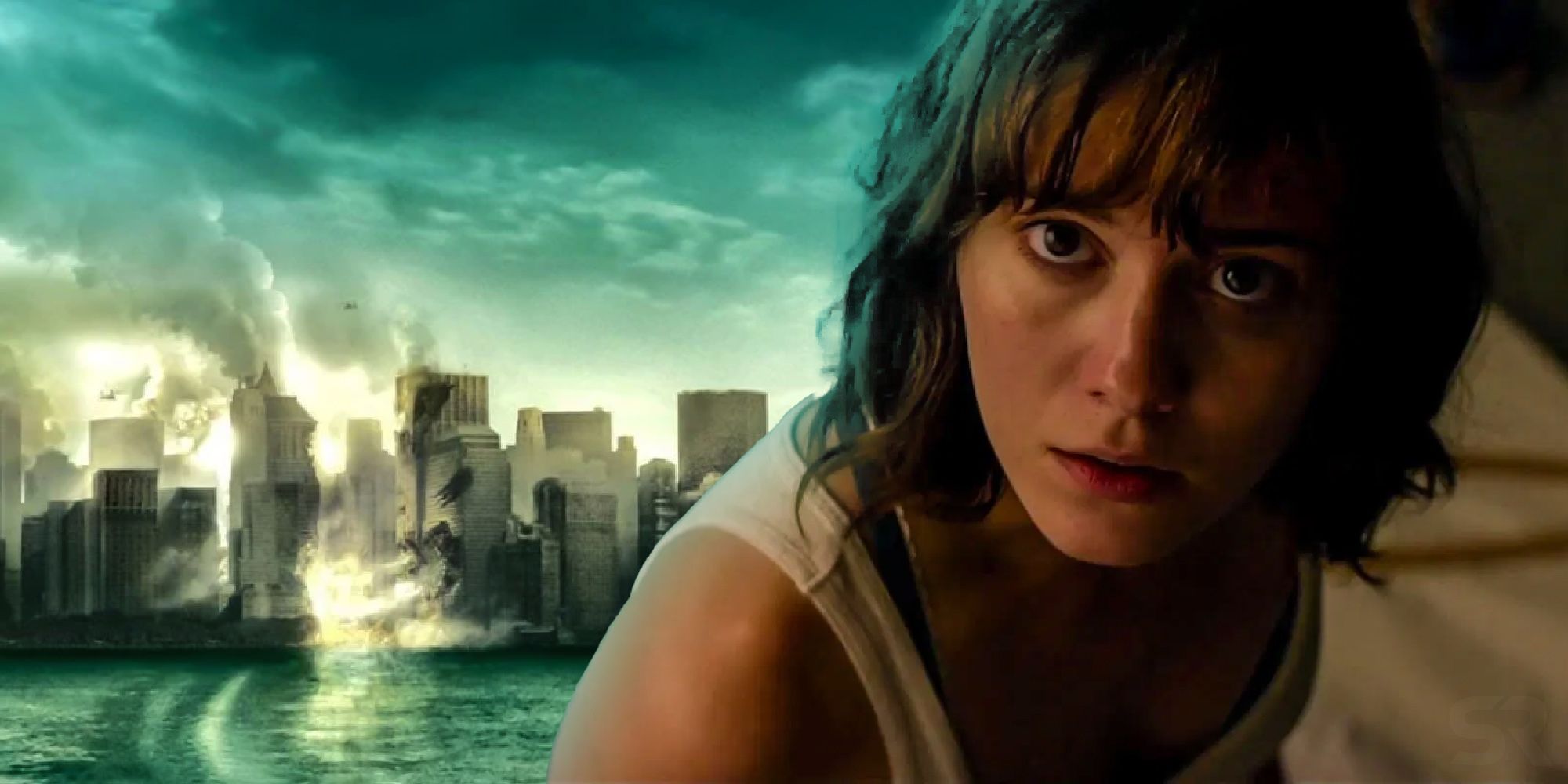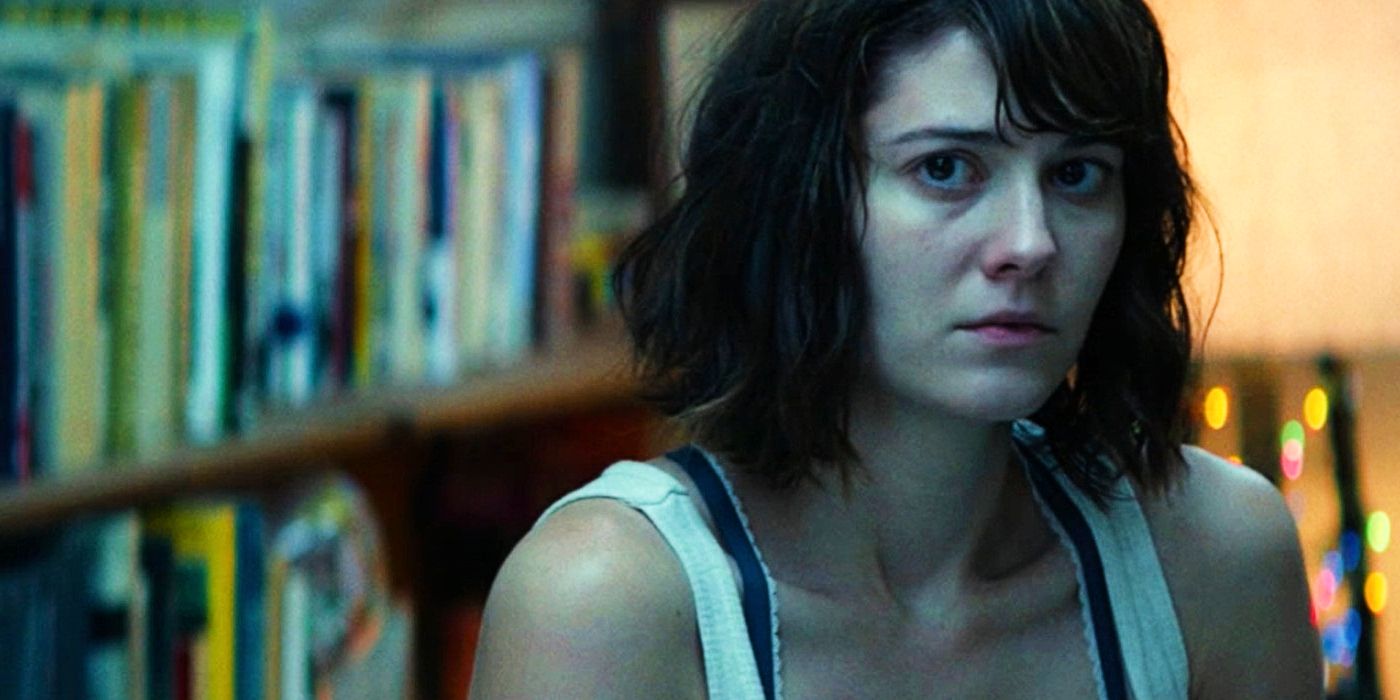The 10 Cloverfield Lane ending is a divisive aspect of the otherwise acclaimed sequel, but it is a conclusion that plays off of the movie’s deeper themes. The second film in the Cloverfield franchise is a deeply unsettling and claustrophobic experience, and from beginning to end presents itself as a cerebral and complex thriller that introspectively tackles themes of paranoia and regret. However, the film bears little resemblance to the 2008 found-footage Kaiju movie Cloverfield, as on the surface it’s only the final shots that link 10 Cloverfield Lane to Cloverfield.
10 Cloverfield Lane begins with Michelle (Mary Elizabeth Winstead) being run off the road and waking up in a bunker where her captor Howard (John Goodman) explains the world is under attack. Putting her doubts aside, Michelle settles into Howard’s bunker alongside Emmett (John Gallagher Jr.). What follows is a tense character-driven drama that delivers a steady flow of dread. There are much deeper themes at play throughout 10 Cloverfield Lane, although — perhaps to its detriment — the ending requires a full examination to explain how it fits into the wider Cloverfield timeline.
What Happens In 10 Cloverfield Lane’s Ending?
Michelle Finally Defeats Howard & Escapes Into A World At War With Aliens
After Howard grows increasingly dangerous and unhinged, Michelle decides to risk freedom in the 10 Cloverfield Lane ending, escaping from the bunker after setting it alight. Dressed in her makeshift protective equipment, Michelle manages to escape the bunker just before it explodes, and she realizes Howard’s insistence that the air is toxic was untrue. Seeing birds fly overhead, Michelle sees that the air is breathable, and removes her mask. However, Michelle escaping Howard’s bunker, while symbolically important, isn’t the main reason the ending of 10 Cloverfield Lane creates so many questions.
The 10 Cloverfield Lane ending sees Michelle opting to go to Houston.
Though aspects of Howard’s claims were false, with the sudden emergence of a giant alien in the sky, it becomes clear the world is indeed under attack. The creature attacks Michelle, and she’s forced to fight for her life, eventually killing the huge being using a makeshift Molotov cocktail. Finally making her way off of Howard’s farm, Michelle finds herself at a literal crossroads, choosing between heading to a safe zone in Baton Rouge or going to Houston to help fight the creatures. The 10 Cloverfield Lane ending sees Michelle opting to go to Houston.
This sequence of events at the end of 10 Cloverfield Lane confused many audience members, especially prior to the release of The Cloverfield Paradox in 2018 which filled in some of the blanks. Until its ending, 10 Cloverfield Lane had been an intimate and tense psychological thriller where the threats from what was happening outside gradually became secondary to Howard’s villainy.
In addition, many of Michelle’s decisions, and why she was held by Howard in the first place, created legitimate questions in their own right. However, the ending does fit the rest of the movie, and an examination of the meaning of 10 Cloverfield Lane and its core themes explains how.
Howard Took Michelle To Rebuild The Family He Lost
Michelle’s Captor Wanted To Replace His Daughter
One of the most suspicious and significant elements of the 10 Cloverfield Lane ending is Howard’s bunker, and the only explanation offered for why Michelle cannot leave it comes from Howard himself. As Howard explains, he brought Michelle there to treat her injuries from the crash. Their subsequent quarantine in the bunker at 10 Cloverfield Lane (which happens to be Howard’s address) came as a result of the attack from unknown forces. However, there’s far more to Howard’s story than he offers Michelle, and this is part of the reason for her distrust of her savior/captor.
The original script, The Cellar, was not connected to Cloverfield in any way.
As Michelle and Emmett later find out, Howard’s regular mentions of Megan aren’t all about his daughter — the picture, and “Megan”‘s clothes offered to Michelle, actually belonged to a local girl named Brittany who went missing several years prior. When Howard’s behavior becomes more delusional, it becomes clear that he’s obsessed with the idea of having a family, and that he wants Michelle to fill the role of his daughter. Michelle and Emmett must fight against Howard, unsure if it’s safe to leave the bunker, but knowing that Howard is a threat to their lives.
Howard was delusional about almost everything, although it’s unclear how much of his story he believed. The fact Michelle found the world experiencing a genuine alien invasion when she left revealed a threat did exist. Howard had connected a few dots but was nowhere near the full picture, and there wasn’t toxic gas in the air as he claimed. The specific nature of the threat was also secondary to his actions. Had he found Michelle after the Cloverfield monsters arrived, he likely would have still held her captive, with the difference being that his story was actually true.
10 Cloverfield Lane Is About Fear & Regret
Howard Had Tried To Replace His Daughter Before
The core themes of 10 Cloverfield Lane are regret and fear, both of which are exemplified by John Goodman’s Howard. Howard’s the film’s primary antagonist as well as Michelle and Emmett’s savior. He’s also a murderer, he’s delusional, and he’s a dangerous conspiracy theorist (even if the conspiracies prove to be true). However, understanding Howard’s backstory is an important part of understanding his motivations throughout the film. Howard’s past is only relayed in part by Howard himself in 10 Cloverfield Lane, making much of what the film reveals about him relatively unreliable.
Howard is a dangerous man, and he has a fixation on filling the role of his missing daughter.
His job working on satellites could serve as a reason that Howard had knowledge of the dangers, and his comments about his daughter and ex-wife being gone take on a sinister tone after the revelation regarding Brittany. Howard is a dangerous man, and he has a fixation on filling the role of his missing daughter, with the implication being that Michelle is the latest in a string of captives. It seems Howard saw his opportunity to take Michelle when the attack started, and used it as a means of keeping her in the bunker with him.
While 10 Cloverfield Lane is a particularly claustrophobic thriller, it’s ultimately not about the bunker, nor is it about the alien attack that made the bunker necessary. The film’s true meaning is revealed in a touching scene between Emmett and Michelle as they discuss their lives before the attack. Emmett explains that he never left his hometown due to his fear of not being successful and that it was perhaps his biggest regret. Michelle shares her own regret, which links back to the very beginning of the film.
Michelle begins the film by running from her fiancé after an argument, and she reveals it to be her usual coping mechanism due to an abusive childhood. This abuse draws parallels to the psychotically paternal relationship Howard attempts to force upon her, and her ultimate resistance shows her attempting to break the cycle of fear and regret. Giving Emmett a backstory with a similar motivation builds a bond between the two characters, and Emmett’s death provides the push that Michelle needs to finally break free of her own fear and escape the bunker in the 10 Cloverfield Lane ending.
The Real Meaning Of 10 Cloverfield Lane’s Ending
Michelle Chooses To Fight & Not Remain A Victim
The 10 Cloverfield Lane ending sees Michelle escape one predator and stumble into the path of another in the form of a large alien threat. While it is an abrupt reveal, it actually provides an interesting continuation of the film’s established themes. By presenting Michelle with yet another monster to face, it allows her an opportunity to fight back, and as she’s only just narrowly escaped one form of captivity, she’s finally inclined to do so.
In the final moments, Michelle is at a critical juncture, choosing between running for safety or fighting the problem head-on. Just like the reveal of Cloverfield‘s monster in the film’s final shot, this scene ties everything together — everything that Michelle has faced throughout the film has led her to that crossroads, and she’s finally willing to fight back. Though 10 Cloverfield Lane‘s final scenes are often cited as the film’s weakest moments, they actually provide an interesting continuation of its deeper themes, as well as tying it all into the Cloverfield franchise.
Why The 10 Cloverfield Lane Ending Was Controversial
The Franchise Twist Undermined The Story
The 10 Cloverfield Lane ending sparked controversy because some viewers felt it was shoehorned into the story to slot it into the wider Cloverfield franchise. It was a jarring leap into sci-fi territory and made little sense tonally if those watching didn’t understand the Cloverfield connection. Many critics felt the ending undermined the rest of the film and 10 Cloverfield Lane would have been better off as a standalone movie with a less genre-bending conclusion. However, even though the 10 Cloverfield Lane ending is controversial, it has just as many supporters.
The sudden change in pace mirrors Michelle’s need to change — and quickly — if she wants to escape Howard and the toxic environment in the bunker. She needs to overcome her fear, especially when it comes to putting herself in danger, and the near-instant push from a slow-creep thriller into a high-paced alien encounter thematically captures the adrenaline panic Michelle would be feeling at the end of 10 Cloverfield Lane. The aliens also represent an unknown she faces when taking that next step, similar to the unknown Emmett feared that kept him from leaving.
She has overcome her fears and knowingly heads into peril.
Many trapped in the kind of abusive relationships 10 Cloverfield Lane masterfully explores have reported that fear of the unknown life beyond their current circumstance left them unable to flee their abuse. This is crystallized in the movie’s final moments when Michelle heads toward Houston against a lightning-flash backdrop of landing alien ships. She has overcome her fears and knowingly heads into peril having developed an awareness that the peace she seeks lies beyond further hardship.
This echoes the experience abuse survivors face when bringing their abusers to light, and the fact that many go on to help other domestic abuse survivors despite the proximity this brings them to their own trauma. With consideration of its ties to the deeper messages of the movie, the 10 Cloverfield Lane ending can be seen as a smarter and more fitting conclusion than it was initially given credit for. A potential 10 Cloverfield Lane 2 might be even more controversial.
Why The 10 Cloverfield Lane Ending Is Perfect For Its Story
Michelle Learns To Stand & Fight – Even Against Aliens
In the end, 10 Cloverfield Lane explained the dangers of systematic domestic abuse, and Michelle was the key to standing up to and ending that form of abuse. Howard was a classic abuser archetype. He was abusive to her from the start, proving that he only wanted to control and dominate her, and not caring about her thoughts or feelings from the start. However, there is a problem with Michelle overcoming and beating Howard. He wasn’t who her abuse problems started with. Escaping this one man was Michelle running away again, even if she did fight for her freedom.
When she beats this monster in the 10 Cloverfield Lane ending, she then had a new decision to make, to either keep running or fight.
Michelle can’t escape this repeating motif in her life unless she does more than just run away. By escaping her captor and moving into the real world again, she realized that there was another predator wanting to hurt her. This was an actual monster. When she beats this monster in the 10 Cloverfield Lane ending, she then had a new decision to make, to either keep running or fight. With giant world-destroying monsters in sight, she chose to fight, and that is how Michelle finally won in the end.
Howard was presented as a paranoid doomsday prepper and, in an ironic twist of fate, his actions prepped Michelle for the alien invasion that was imminently due to unfold.
10 Cloverfield Lane’s Place In The Cloverfield Franchise Timeline
Cloverfield Takes Place Only A Short Time After The First Movie
|
Film |
Release Date |
Director |
|---|---|---|
|
Cloverfield |
January 18, 2008 |
Matt Reeves |
|
10 Cloverfield Lane |
March 11, 2016 |
Dan Trachtenberg |
|
The Cloverfield Paradox |
February 4, 2018 |
Julius Onah |
Making connections between Cloverfield and 10 Cloverfield Lane is more difficult than it might seem, particularly as the sci-fi premise of the latter is kept back until the very end of the film. This makes it difficult to pin down 10 Cloverfield Lane‘s exact place in the loose narrative of the Cloverfield franchise. However, a few small Easter eggs do point to a specific placement in the wider Cloverfield timeline.
It’s reasonable to assume that the events of 10 Cloverfield Lane happen at least a short while after the events of Cloverfield, as the former chronicles the initial appearance of the monsters in New York, and at the end of 10 Cloverfield Lane, the monster issues appear to be worldwide. However, each of the current films in the Cloverfield franchise is designed to be entirely independent of each other.
There’s also a small Easter egg within 10 Cloverfield Lane‘s promotional material that confirms Howard was working for Tagruato, the same company that hired Rob at the start of Cloverfield, and a conspiracy theorist in The Cloverfield Paradox who shares the name “Stambler” with Howard.
Cloverfield 4 Needs To Explain The Franchise Timeline
Fans Seem Confused At How The Movies Connect
With the 10 Cloverfield Lane ending not directly referencing how it fits into the timeline of the first Cloverfield, it presented the idea that this franchise was loosely connected. It is an interesting approach, creating a sci-fi horror anthology under the Cloverfield umbrella with each release tackling a totally new story in the genre, similar to the original idea for the Halloween franchise. However, three movies into the Cloverfield franchise and the confusion surrounding how it all connects is proving to be harmful to the audience’s acceptance of these films.
The underwhelming response to The Cloverfield Paradox cemented the fact that the franchise needed to find some focus if it was going to continue. The third movie initially seemed like a standalone space-set story only for the final moments to reveal a much bigger version of the original Cloverfield monster on Earth. Connecting the story more directly to the first Cloverfield while still implying that it is a different universe, only adds to the confusion of things.
Whatever the next project is will be a make-or-break moment for the franchise
Cloverfield 4 is confirmed, and given the secrecy of the films up until now, it could arrive at any time. However, whatever the next project is will be a make-or-break moment for the franchise as there is the need for a movie to tie everything together and give fans some clarity and yet another standalone with only vague connections to the other releases could kill interest in the future of Cloverfield all together.
How The 10 Cloverfield Lane Ending Was Received
The Movie Received Positive Reviews Despite The Ending
10 Cloverfield Lane received great reviews when it came out, and the audience also enjoyed it. Thanks to the low budget ($13-$15 million), it was a box office success, making $110.2 million (via Box Office Mojo), and much of that comes down to positive word of mouth. However, even the positive audience reviews didn’t necessarily like the ending. One audience member wrote, “I basically liked the film but thought the ending was contrived and far fetched by forcing it to tie in with Cloverfield.“
The critics agreed in many cases. In his review, Leonard Maltin wrote that the movie succeeds in “building tension through a series of thriller tropes, some of them bordering on cliché but still pretty effective.” However, after praising John Goodman’s performance, Maltin added, “The finale (which is reminiscent of Cloverfield) doesn’t have the impact it should.“
Not all reviews are positive though. Owen Gleiberman from BBC wrote that “10 Cloverfield Lane feels like a marketing plan posing as a movie.” That comes down to the twist ending that makes the film part of the larger franchise:
“In the case of 10 Cloverfield Lane, what’s attention-grabbing about the film’s last act is mostly that it seems like it was lifted out of another film entirely. In today’s conformist popcorn environment, that can play as audacity. But really, it’s just desperation, as if the filmmakers were eager to do anything under the sun to set the audience abuzz.“
Which Cloverfield Movie Has The Best Ending?
The 2008 Original Keeps Things Simple
The overall Cloverfield franchise has been met with some mixed responses over the years, but that is especially true of the endings to these movies. While all three films in the franchise thus far have differed in quality, it could be argued that none of them have really stuck the landing in a meaningful way. A big part of the issues with these endings has been the tendency for them to promise a bigger story to come which never comes to fruition.
10 Cloverfield Lane‘s abrupt tonal shift in the final moments opens the world of this massive alien invasion and humanity fighting back. While this is an exciting cliffhanger for the movie, it doesn’t necessarily give the audience the feeling of a fulfilled story of the movie they just watched. The criticisms 10 Cloverfield Lane received for its ending shoehorning in the connection to the franchise is outdone by The Cloverfield Paradox ending. Not only does it not have the strong character resolution of 10 Cloverfield Lane, but the sudden appearance of the Cloverfield monster is confusing rather than exciting.
With these flaws weighing down the other endings, the original Cloverfield manages to have the most satisfying ending by presenting it as a standalone story. It is true that there is a small tease at the end of Cloverfield that could set the stage for Cloverfield 2 if it ever happens, but the movie’s ending brings the story to a real conclusion that returns to the characters at the center of the journey.
It is not a completely thrilling ending, but it does maintain the movie’s intimate look at a monster attack movie as well as using the found footage format to bring the story to an emotional end.
The movie ends with the main characters Rob and Beth facing the apparent demise together as the military bombs the city remains in an attempt to kill the monster. As they huddle together and the explosions are heard, the movie cuts to another video of them on a date in Coney Island, sharing a happier time. It is not a completely thrilling ending, but it does maintain the movie’s intimate look at a monster attack movie as well as using the found footage format to bring the story to an emotional end.
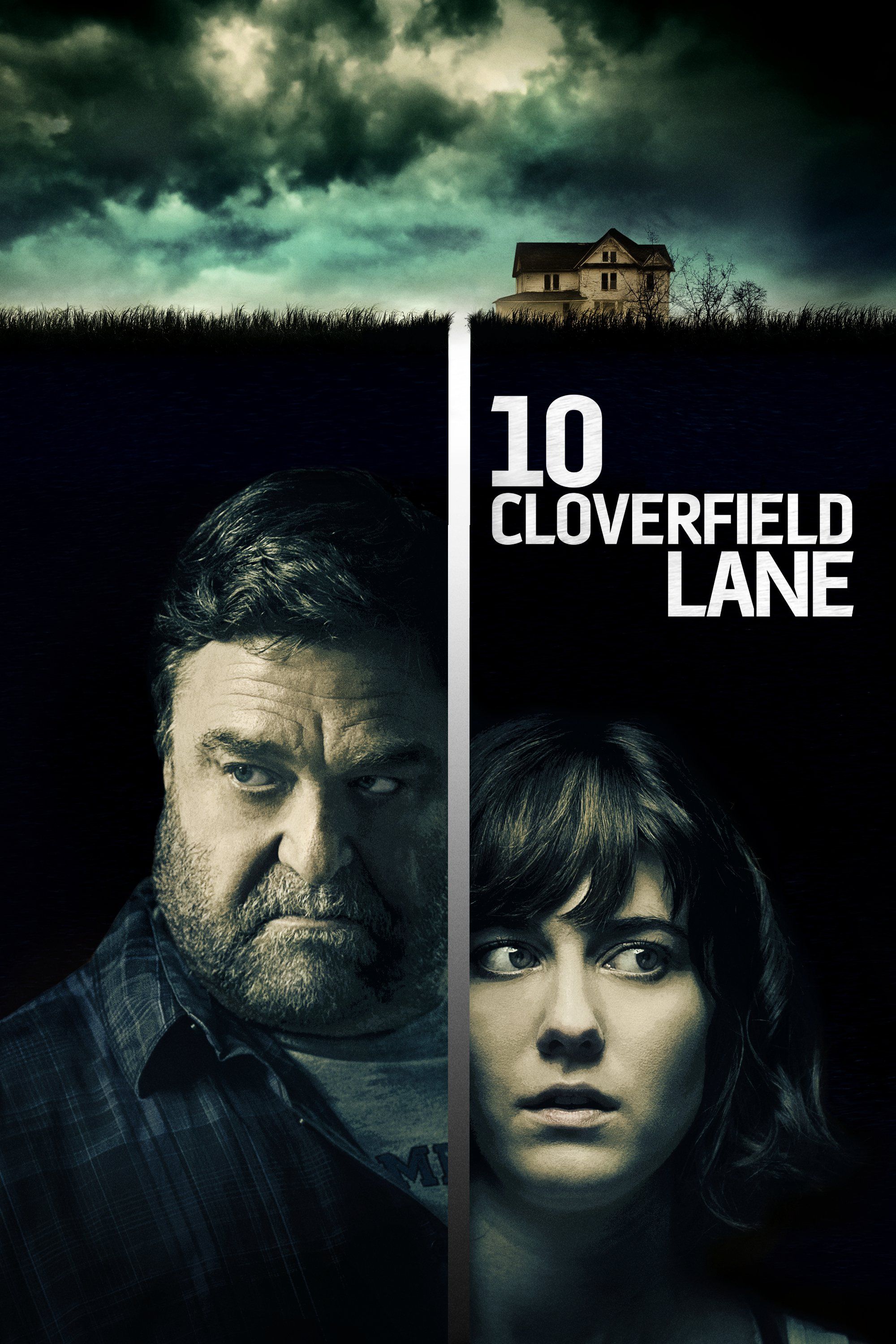
From Dan Trachtenberg, 10 Cloverfield Lane follows Michelle (Mary Elizabeth Winstead), a young woman who awakens after a car crash in a bunker alongside two strangers. Howard (John Goodman) tells her that it’s not safe to leave, and that he saved her life, but Michelle becomes increasingly suspicious of Howard’s motives and his past and begins to plan a daring escape to see what exactly has happened to the outside world.
- Director
-
Dan Trachtenberg
- Release Date
-
March 10, 2016
- Distributor(s)
-
Paramount Pictures
- Runtime
-
103 Minutes

